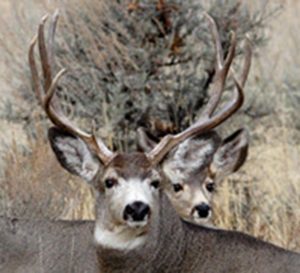 Officials from Montana Department of Fish, Wildlife and Parks were in Florence last week at a community meeting sponsored by the Riverview Orchards Landowners Association to address the homeowners’ growing problem with browsing herds of deer, some even showing threatening and aggressive behavior towards pets and humans.
Officials from Montana Department of Fish, Wildlife and Parks were in Florence last week at a community meeting sponsored by the Riverview Orchards Landowners Association to address the homeowners’ growing problem with browsing herds of deer, some even showing threatening and aggressive behavior towards pets and humans.
Fish, Wildlife and Parks Bitterroot Wildlife Biologist Rebecca Mowry and local FWP Game Warden Justin Singleterry stressed the need for public involvement and public input in the process of managing wildlife.
“The wildlife is not ours, FWP does not own the wildlife. The government does not own the wildlife. In Montana, the wildlife belongs to the public,” said Mowry. “It’s my job to see that we are not doing something biologically harmful to the animals.”
Singleterry began by pointing out that there are laws which place “sideboards” on what the agency and the public can do with wildlife. At the same time there are some regulations, adopted by certain agencies, that have to be followed.
Add to this the regulations that private citizens can place upon themselves, like subdivision covenants, and you have a complex mix that can easily cause conflict. In this case, for instance, hunting is the main tool that FWP uses to manage wildlife populations. But as Bill Swendsen, President of the Riverview Orchards Landowners Association, made clear, the covenants on the 119 residents state clearly that “No wild bird or animal shall be trapped, hunted, or killed within the properties, except for protection of life and limb or to prevent unreasonable property damage.” He stated later in the meeting that there was no chance of that hunting restriction being lifted.
Bill Scullion, president of another homeowners association located on Eight Mile Road, came ready to talk about what’s “reasonable” in terms of property damage. He said two years ago he had over $10,000 in landscaping destroyed by over fifty deer. He said they conducted a survey and counted over two hundred to three hundred deer within about a five-square-mile area.
Homeowners in his association don’t allow hunting either. But that didn’t stop Scullion from promoting hunting in the surrounding area. FWP did what they could by raising the number of permits for mule deer doe in that hunting district from 200 to 300. Scullion thinks it’s been something of a success for him. He said last year he did not see a single deer in his yard.
“But to tell you the truth,” he said, “I think we just drove them down to the people living down below and now they have a problem. Something has got to be done. It’s a growing problem.”
Addressing a deer problem within any given subdivision by managing the deer in the surrounding area is also very complex. Singleterry and Mowry gave a short history of how the hunting districts were devised, each with its own set of regulations and limits, and how they have been amended in recent years.
But the scientific management of wildlife is one thing and the goals of that management are something else. People want different things when it comes to wildlife. Some just want meat, for instance. Some just want horns.
According to Singleterry, Ravalli County has two of the most popular trophy districts in the state, #270 and #261. He said trophy hunters can really get obsessed. He said there are guys that go out all the time and take photographs of the deer and get to know them very well. They’ll even trade pictures like baseball cards. They watch the animal for years and wait until they get the tag and then they know right where to go and when to get their trophy.
Other people are not so interested in special events and want a dependable and plentiful supply. Other people may want a little less deer in the area, period.
“For every change you want, somebody wants something different. Our job is to balance that and protect the resource at the same time,” said Singeterry.
Singletree said in areas where covenants prevent hunting that the best thing to do is to become “deer aware” the way many people, especially on the west side of the valley, have to be “bear aware.” He said there are things you can do that will attract the deer. If you don’t want the deer, you should quit attracting them. Plant things that they are not inclined to eat. Don’t plant fruit trees, for instance. If you have a food source, like a hay stack, or